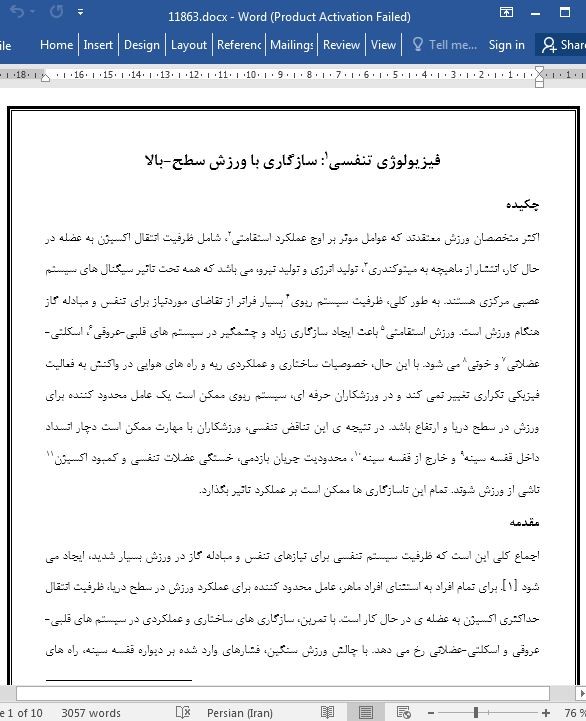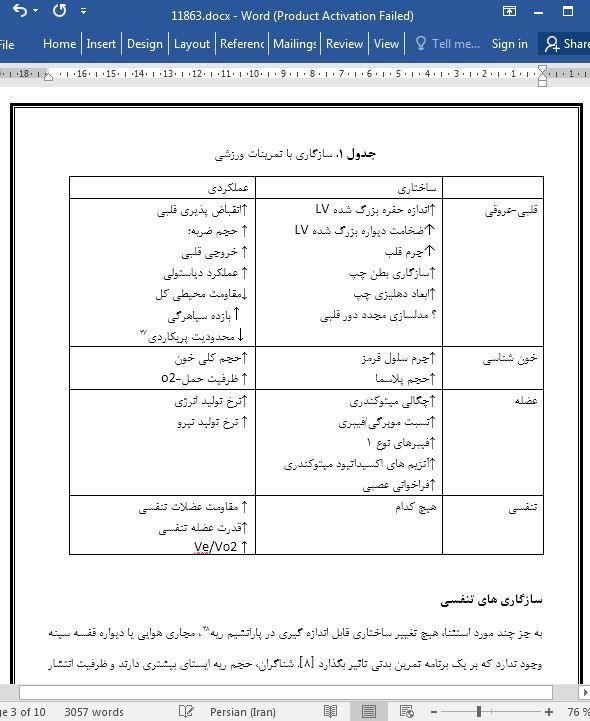
فیزیولوژی تنفسی : سازگاری با ورزش سطح-بالا
چکیده
اکثر متخصصان ورزش معتقدند که عوامل موثر بر اوج عملکرد استقامتی ، شامل ظرفیت انتقال اکسیژن به عضله در حال کار، انتشار از ماهیچه به میتوکندری ، تولید انرژی و تولید نیرو، می باشد که همه تحت تاثیر سیگنال های سیستم عصبی مرکزی هستند. به طور کلی، ظرفیت سیستم ریوی بسیار فراتر از تقاضای موردنیاز برای تنفس و مبادله گاز هنگام ورزش است. ورزش استقامتی باعث ایجاد سازگاری زیاد و چشمگیر در سیستم های قلبی-عروقی ، اسکلتی-عضلانی و خونی می شود. با این حال، خصوصیات ساختاری و عملکردی ریه و راه های هوایی در واکنش به فعالیت فیزیکی تکراری تغییر نمی کند و در ورزشکاران حرفه ای، سیستم ریوی ممکن است یک عامل محدود کننده برای ورزش در سطح دریا و ارتفاع باشد. در نتیجه ی این تناقض تنفسی، ورزشکاران با مهارت ممکن است دچار انسداد داخل قفسه سینه و خارج از قفسه سینه ، محدودیت جریان بازدمی، خستگی عضلات تنفسی و کمبود اکسیژن ناشی از ورزش شوند. تمام این ناسازگاری ها ممکن است بر عملکرد تاثیر بگذارد.
مقدمه
اجماع کلی این است که ظرفیت سیستم تنفسی برای نیازهای تنفس و مبادله گاز در ورزش بسیار شدید، ایجاد می شود [1]. برای تمام افراد به استثنای افراد ماهر، عامل محدود کننده برای عملکرد ورزش در سطح دریا، ظرفیت انتقال حداکثری اکسیژن به عضله ی در حال کار است. با تمرین، سازگاری های ساختاری و عملکردی در سیستم های قلبی-عروقی و اسکلتی-عضلانی رخ می دهد. با چالش ورزش سنگین، فشارهای وارد شده بر دیواره قفسه سینه، راه های هوایی و مکانیسم های تبادل گاز، محدودیت هایی را برای تامین تنفس دقیقه ای مناسب و تبادل گاز در محیطی که تقاضا از عرضه بیشتر است، فراهم می کنند. در این موارد، سیستم تنفسی عاملی محدود کننده است- کمبود اکسیژن شریانی بوجود می آید و VO2max و عملکرد تحت تاثیر قرار می گیرند.
ABSTRACT
Most exercise scientists would agree that the physiological determinants of peak endurance performance include the capacity to transport oxygen to the working muscle, diffusion from the muscle to the mitochondria, energy production and force generation, all infl uenced by signals from the central nervous system. In general, the capacity of the pulmonary system far exceeds the demands required for ventilation and gas exchange during exercise. Endurance training induces large and signifi cant adaptations within the cardiovascular, musculoskeletal and haematological systems. However, the structural and functional properties of the lung and airways do not change in response to repetitive physical activity and, in elite athletes, the pulmonary system may become a limiting factor to exercise at sea level and altitude. As a consequence to this respiratory paradox, highly trained athletes may develop intrathoracic and extrathoracic obstruction, expiratory fl ow limitation, respiratory muscle fatigue and exercise-induced hypoxaemia. All of these maladaptations may infl uence performance.
INTRODUCTION
There is general consensus that the capacity of the respiratory system is overbuilt for the demands placed on ventilation and gas exchange by highintensity exercise.1 For all but the highly trained, the limiting factor to exercise performance at sea level is the capacity for maximal oxygen transport to the working muscle. With training, structural and functional adaptations occur in the cardiovascular and musculoskeletal systems. The stresses placed on the chest wall, airways and gas exchange mechanisms by heavy exercise challenge the limits to provide adequate minute ventilation and gas exchange in an environment where the demand exceeds supply. In these instances, the respiratory system is the limiting factor – arterial hypoxaemia ensues and VO2max and performance are affected.
چکیده
مقدمه
عوامل تعیین کننده فیزیولوژکی بر عملکرد
تنفس حین ورزش
سازگاری با تمرین ورزشی
سازگاری های تنفسی
محدودیت های تنفسی در عملکرد
کمبود اکسیژن شریانی ناشی از ورزش
اختلال مجاری صوتی
محدودیت جریان بازدمی
تمرین/خستگی عضله تنفسی
خلاصه
منابع
ABSTRACT
INTRODUCTION
PHYSIOLOGICAL DETERMINANTS TO PERFORMANCE
RESPIRATION DURING EXERCISE
ADAPTATION TO TRAINING
RESPIRATORY ADAPTATIONS
RESPIRATORY LIMITS TO PERFORMANCE Exercise-induced arterial hypoxaemia
Vocal cord dysfunction
Expiratory fl ow limitation
Respiratory muscle fatigue/training
SUMMARY
REFERENCES
- اصل مقاله انگلیسی با فرمت ورد (word) با قابلیت ویرایش
- ترجمه فارسی مقاله با فرمت ورد (word) با قابلیت ویرایش، بدون آرم سایت ای ترجمه
- ترجمه فارسی مقاله با فرمت pdf، بدون آرم سایت ای ترجمه



